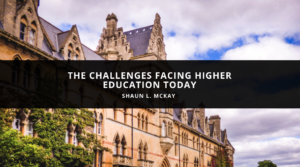Shaun L. McKay Explores the Challenges Facing Higher Education Today


The Challenges Of Attending College In Today’s Complex and Changing World:
For many people, college is seen as the key to success. For a very long time, I have shared and surmised that “Through Education comes Transformation and Economic Empowerment.” The demands placed upon individuals seeking to join the economic infrastructure require technical expertise and critical thinking/reasoning. Students who seek to attend a Higher Education Institution after High School are assessed by using transcripts from the High School, SAT’s, ACT’s, etc.
However, a segment of these students fall outside of the College’s expected scores and will be placed into remediation for their respected field, setting them back a few years. Several colleges and Universities have recently devised plans to phase out of testing and have incentivized their campuses to utilize varying forms of information intake and retainment, allowing students to graduate in a compressed time period (*i.e. California). Simultaneously, when looking at higher education today, many major issues have to be overcome. Shaun L. McKay is an expert in this field, and he is here to review some of the challenges facing this community today.
For example, the challenges students face outside of the institution face an uphill battle to provide the requisite services today. The following are just a few of these obstacles that affect both the student/institution and the overall economy to which they intend to enter:
- Many students want to pursue their studies at higher education institutions and have limited financial resources and have expenditures notwithstanding those students that rely upon public transportation and daycare.
- Students pay lower tuition, but quite often, most live with their parents while saving money from part-time work to help defray costs (*many work full-time when you count the number of hours at several part time jobs).
- Community colleges do not receive the support they once did due to cash-strapped states/counties and the lack of federal funding to them, placing a larger financial burden on all stakeholders.
- This will call for new or expanded funding options for both students and community colleges.
- Already, some corporations support students in pursuing college study — McDonald’s is one of the better-known companies that do so.
- Private/public partnerships may be the means toward providing students the support they need to attend college and may provide the communication between business and higher ed to determine what students need to learn in this ever-changing economy.

Shaun L. McKay Reviews the Cost of Higher Education and the Impact on Students
One of the first issues that Shaun L. McKay has to discuss is the cost of higher education. This is a competitive environment for students as well as the schools themselves. For schools to keep up with the competition, they need to account for students’ amenities as they plan for the academic year. At the same time, this leads to major issues for students who cannot afford to attend college due to the costs that they will incur. Shaun L. McKay knows that students are living in demographic areas that can be costly to live in or have expectations of eligible candidates that companies may be seeking to fill the drought in vacancies becoming available. It’s also known that candidates need at least a Community College Degree to make just above minimum wage, and still, this is not enough to address the lack of livable wage to cover their expenses. These candidates are frequently either not qualified for jobs advertised as they are just starting their careers, so how can they afford these bills? This has led to many people relying on loans to attend college. These loans can weigh down students with debt that can last for years, and even with the degree, the salaries do not keep pace with the economic realities these future graduates face upon leaving College.
Shaun L. McKay Discusses the Limited Availability of Slots at Schools
Shaun L. McKay also knows that it can be challenging for some students to be accepted into the country’s top schools. In some cases, students are well-qualified, but the school does not have enough seats. Therefore, many students end up going to schools that might not offer them the same opportunities. Shaun L. McKay believes that schools need to work harder to provide more options to qualified students with a pathway to attain their goals for advanced studies ultimately.
Many Graduate programs can articulate with institutions at the Community College level for a seamless pathway to baccalaureate and ultimately a master’s Degree. Whether it is a 2+2, 2+1+1, or a 2+2+1, no matter the format to get to completion successfully, all institutions of Higher Education must now adapt and adjust their traditional quarterly or semester based offerings… For example, I created an early morning (6:30-10:45) Am option at my last institution, along with a developing evening and weekend curricula that enabled students to complete their degree requirements in two years. Additionally, I charged my staff to revisit all transfer pathways and contact these institutions so that our students will have all of their credits to be accepted by the receiving institutions. Student success does not end upon the completion of the degree requirements. Institutions must be aware of their graduates’ economic demands and what the other Higher Education Institutions seek from transfer students. This is the only way students will develop their foundational talents and be either ready for work or advanced standing when competing for slots in their particular areas of further studies.
Shaun L. McKay Explains the Impact of the Pandemic on Schools Today
Finally, it is also important to take a closer look at the pandemic’s impact on educational institutions. Shaun L. McKay knows that schools are struggling to make ends meet; however, the reality is that these schools may need to cut costs to afford the privilege of having students back on campus. This includes expenses for COVID testing and contact tracing while, at the same time institutions have to upgrade and bolster their technology platforms. The Covid-19 pandemic forced Colleges and Universities to take an in-depth look at curricular offerings and what should be utilized along with technical offerings and labs required by accreditation agencies for certification to be maintained/attained. Some students may not have the ability to access these courses via technology for varying reasons:
- Access to Wi-Fi or Hotspots has dramatically changed the lives of all involved in the academic environment in a myriad of ways. Not everyone has access to these services, and others may experience intermittent service problems enabling setbacks in where they may be in the duration of the courses and academic calendars.
- Affordability (Acquiring laptops/computers) may be a problem for students that do not have enough financial aid or in other cases, individuals that are not on financial aid may not be able to procure and acquire laptops/desktops/other smart devices to handle zoom, skype, WebEx, and other similar forums for their classes.
- Unfamiliarity with the teaching modality may cause the failure and dropout rates to increase, so training and enhanced support is required for everyone involved with the transfer of knowledge via this medium.
- Institutions must ramp up their technology and software programs to be ahead of the existing needs and not fall behind. Technology is as good as its latest installation, and institutions must ensure that this area remains a key element in its strategic priorities listing aligned with assessment, budgeting, and planning.
- Adaptability to change mid-semester and having never been exposed to such changes can release some anxiety while addressing the safety of themselves and others in new settings. The CDC has policies and directions that can also be involved in academia to change its operations.
- The lack of face-to-face counseling or meeting with professors is a significant shift away from the norm. Thus, institutions and all involved will need to be amenable to this shift and adapt accordingly.
- Mental Health Counseling has become more of a dominant need for students and their families during the pandemic. Institutions must adjust their services via technology to meet their students, faculty, and staff’s needs.
- Faculty that traditionally advised students in a face-to-face modality must now work with their respective institutions to ensure measures are in place to meet students in their academic pursuits and provide the requisite support.
- Food Insecurity is also a problem as students relied on meal plans at their colleges daily and utilized financial aid to cover these costs. Being off-campus with a college-issued debit card or meal plan card created additional stress for these students during this period. Institutions must devise plans to address this significant need.
- The increased costs of attending colleges and universities during the pandemic are a matter that some institutions addressed by maintaining the prior year’s tuition rates and providing additional scholarships via their Foundations and other philanthropic efforts.
The pandemic has impacted part-time students and parents to a point where jobs that were once open are no longer available. Therefore everyone within the academic environment is impacted in various ways. Our part-time faculty may no longer have sections to teach. Students may no longer have part-time jobs they once had to offset costs. Students are also faced with housing and food insecurities, transportation that were once available has now become a challenge for working moms and dads (Students), unemployment funding does not fully replace the costs that were made via multiple jobs.
Resilience and adaptability have become the norm for everyone, and we all need to remind ourselves that no one policy can address every need of the impacted groups. Our respective institutions’ mission and vision must now be revisited as they may have been established to address academia in a different way than what we are faced with today. Higher Education must lead the way and be at the forefront of this effort to help transform “the new normal” and train those in the Allied Health and Medical fields through the Corporate, Service, Governmental, and Policy areas. Once again, we are being asked to do more with less, and as we have always done, we must and will do such!
